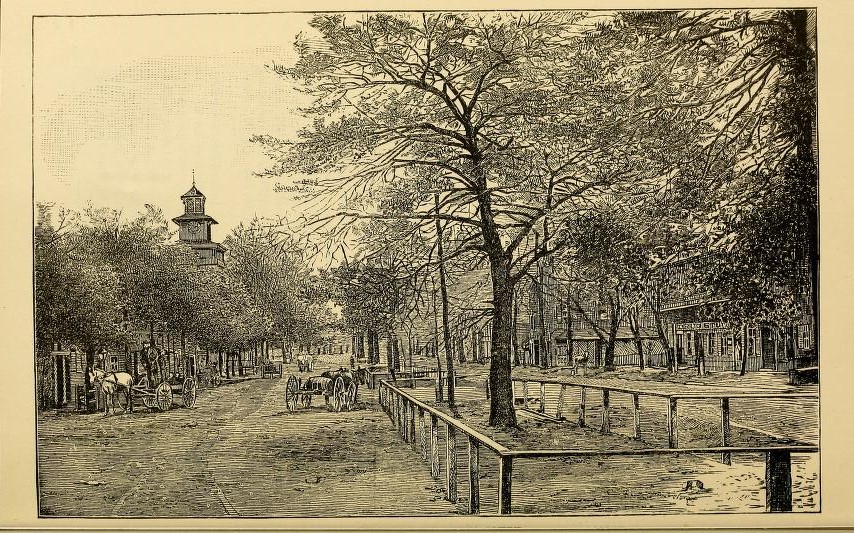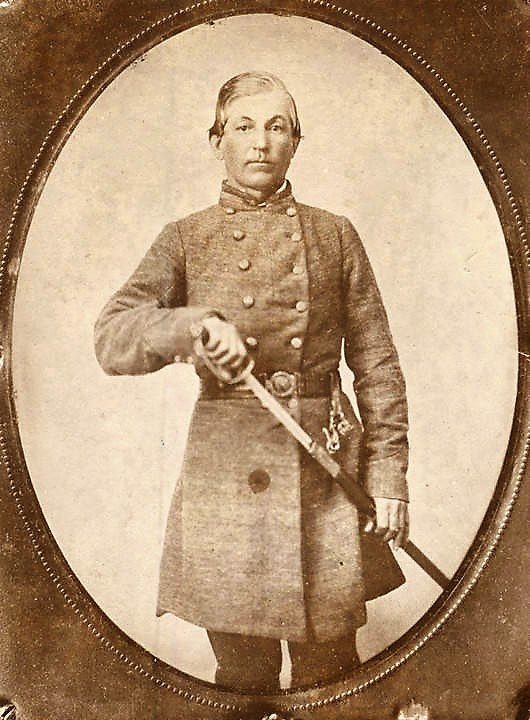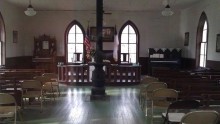Scroll down to read story
COLUMBIAN INSTITUTE
By
Levin Vinson Rosser1 of Carrollton
(Transcribed article from Transactions of the Alabama Historical Society, Volume 2, 1898)
The founder and principal of this Academy, (Ed.) Columbus Tarrant is supposed to have named it in honor of the great (faded) for whom he himself was named.
Columbian Institute was situated at Taylorville, Tuscaloosa County, Ala. four and a half miles south of the county seat, at (faded) of the Greensboro and Centreville public roads. Here, (faded) and some two hundred yards from the former (faded) immediately on the north side of the latter, is a shady (faded) of forest oaks, and gently sloping southward to (faded). This formed the front lawn and study-ground. Back of the g(faded) at the center was the family residence, a spacious (faded) building with an L at each end, in outline (faded) like a printed capital H, thus affording a wealth of (faded) veranda about the numerous airy rooms. Near by, to the west of the residence, with the grove in front and the garden in the rear, were the dormitories, framed cottages, for the use of the boys. On the east side of the residence there stood two school-houses. The older, a one-story frame, with an L in the rear, was further eastward; the newer, a one-story framed structure lathed and plastered inside and out, consisted of a main hall with a small room on each side and an ornamental portico in front. It stood between the older and the family residence. The side rooms were filled, one with a library, the other with scientific apparatus. To the eastward of the school-houses, there was an open old field, where, during the recesses, “town-ball” was wont to hold full sway.
Q4312 This photograph was previously identified as Edward W. Tarrant, the son of Edward C. A note on the back reads, “Capt. Ed. Tarrant Commander Tarrant’s Battery C. S. A.” On close inspection it is unclear whether the man depicted is in his twenties or forties, and since both men served as officers in the battery, there is still a possibility that this is the son. The jacket is jean cloth, indicating that the image was made mid to late war, no insignia is visible on the collar. (Edward C. Tarrant was born in 1819 and died in 1878. Edward W. Tarrant was born 1842 and died in 1921. – Alabama Department of Archives and History)
Eighty pupils attended in 1860s
Thus appeared the Institute in its palmiest days, 1861-2. At that time it had about eighty pupils, some twenty or thirty of whom were boys boarding at the Institute; the others were children of the neighborhood or their relatives or friends, boarding with them, and mostly boys, as only small girls usually attended. At this time the Institute was under military discipline, and the principal was assisted by his son, John, who was Commandant. The latter was a graduate of the University of Alabama, and, like the other children of the principal and many of his more advanced pupils, served his apprenticeship in the Institute as a pupil teacher. In fact, this system, that of pupil-teacher, was one of the marked characteristics of the school and its master, thus enabling him to handle successfully a large number of pupils without paid assistants. But he also had regular assistants, one and the first of whom was Mrs. Caroline Kirby.
The community in those ante-bellum days consisted mostly of slave-owning planters, if not wealthy, at least well to do and independent, some with plantations on the rich bottom lands of the Warrior River, the slaves numbering from ten or twelve to fifty or sixty to each family. Tuition fees were usually $2.00 to $4.00, and board $10.00 to $12.00, a month. All bills were collectible and were uniformly paid, at least by the close of the year. By common consent the public money which the pupils of the Institute were entitled to draw was donated to the payment of the tuition of the few poorer children of the district. The patronage was drawn not only from the adjacent neighborhoods but from the adjoining counties and from Mississippi. The boarders were mostly the sons of wealthy planters, many of whose names cannot now be recalled. Among them may be mentioned Lofton, Gordon, and Eatman, of Pickens; Hale, Shelton, Linebaugh, and Allen, of Greene; McAdory and Spencer, of Jefferson.
Principal served in the Civil War
In the second year of the Civil War, the schoolmaster became the soldier, and the master of boys was easily transformed into the leader of men in an artillery company. 3 But when the war was over the instincts and fixed habits of the teacher re-asserted themselves and the school was resumed as “Pelham Institute,” a name given in honor of him who had displayed so great ability in the same branch of service as that in which our schoolmaster had been engaged. For some seven or eight years the school was continued under this title, and for a time flourished under the assistance of his accomplished daughters, Misses Anna and Sallie, but it never quite regained its ante-bellum prestige. With the waning prosperity of the community and the failing health of the founder, it gradually declined and finally closed a few years before his death in 1878.
The course of study, like that of even the best schools of the times, consisted, for the elementary grades, chiefly of the “three R’s” (arithmetic, reading and writing), and for the higher grades, of Latin, Greek, and Mathematics; but no grade was rigidly limited to these. On the contrary, the practical side of life and the proper preparation therefor were ever present int eh principal’s mind and methods. Practical arithmetic, bookkeeping and the natural sciences were not overlooked. These studies sometimes formed the nucleus of a separate summer school. But the chief object of this master-teacher was to instill in the mind of the pupil the courage of self-reliance. Hence, we derive his motto and universal text, “Learn how to learn,” He maintained that the regular course of Latin, Greek, and Mathematics afforded the best means of learning this great lesson of life. He claimed also that the chief object of the teacher was not to impart knowledge to the pupils, but to make him the master of this mystery of learning how to learn. Therefore, he was not a lecturer, nor a demonstrator of facts, nor a worker of sums; but by means of a few well directed questions he caused the pupil to begin to think and to do for himself. He had discovered and thoroughly appreciated the value of blackboards, charts, globes, the numeral frame, and the like aids in school-work, most of which he used continuously, especially the blackboard.
He was an expert disciplinarian, never losing control of himself and always master of every situation. His knowledge of human nature as exhibited by boys and girls was remarkable, always enabling him from appearances and circumstances to locate the seat of mischief. Shrewd and a hero indeed was the mischief-making urchin who could evade the detective eye and ear of “Old Ed,” as he was familiarly known to his school-boys. In his early career he was noted for his use of the rod; but in later life he entirely abandoned this “indiscretion of youth,” as he called it. His experience along this line is worthy of note. In a conversation with the writer of this sketch, a former pupil of his, when the latter was about to assume the role of the pedagogue, looking back over his long career and varied experience in the school room and counselling his pupil as a father would a son, he said that the indiscreet use of the rod had given him more trouble than all other causes combined.
Life-time work
Teaching was the life-time work of this exemplar of the profession. He began it at the age of twenty in 1840,4and taught in Pickens, Jefferson, and Dallas, as well as in Tuscaloosa, Counties. It has been claimed for him that he educated more boys in Alabama than any contemporary teacher, except, perhaps, the noted Henry Tutwiler, of Green Springs. Among his pupil teachers, besides his own children, may be mentioned J. T. Yerby, who became a prominent Baptist minister, as well as teacher. The want of proper records and the lack of accurate information prevents the mention of others. This sketch would not be complete without some mention of her, to whom more than one intimate and life-long friend of this family have said that Capt. Tarrant and his children owe all that they have accomplished in life– Permelia A. Van Zandt, who became his wife in their youth. She was the gentle, persistent and consistent power behind the throne that moved and regulated this little kingdom.
After the death of its founder, the Institute suffered much, not only from the ordinary ravages of time and neglect, but from a hurricane which swept over it in 1885 and dismantled most of the premises, so that there is now left but a remnant of the former structures. A three-months free school of a handful of children in a dilapidated old house now represents this once noted Institute. The aged and beloved widow still lives, and with her daughter, Miss Sallie, occupies the remnant of the family residence.
APPENDIX
Compiled List of pupils of Columbian Institute
In the absence of any known catalogues, the list below is appended. It is far from perfect, however. Those known to be dead are indicated by a *.
(Note by transcriptionist – this list was badly faded)
Alen, Thomas B.
Brooks (?), Wade*, W (faded)*, Pempie?, Beulah* Mark.
Chandler, Thomas, * Asa*
Chids, W. he? *
Clements, Easter*
Cribbs, Ed, Ces ?, Carne?*
Eatman, K. M., Fe—?
Eddens, Joe?, Jesse?, Sam, Charley?
Farmer?, Joe, Dan?*, —–?, Margaret*
Fergrson?, Perry
Gorce,?, Nap
Ha- ey, John D.*, K—-?, –F. –,*, William*
Henegr? Sam*, —–, —, Henley
Hargrove, ——-
He–?, Cha?*, Wiley*
H—–,Grand?
Head, —?, James, David
Ivey, John
K—, Was
(From here to Owen – too faded to transcribe)
Owen, —*, —–
Ogburne ?, James, —, —-
Spencer, —-, —-, —-
Thompson, James?, Jack? F—-, Shum?, —–, —-, Judson
Tarrant, John,*, William, Anna, *Sallie
Waldrop, Green B.
Walker, Robt. J.,8, Hick. P., John, William*
Wilds, Sarah, Willie
Willingham, Woodford
Willingham, Rufus, Caroline, Catharine, Berry,* Bill Hanner, John*
Winn, James
Witherspoon, Pink.,* Wilson,* Willie,* Leah,* Sallie,* Hester.*
Woods, George.
Yerby, Miles, John T.*
Pelham Institute
Allen, Beverly.
Andrews, John.
Barbour, Harace,* Dollie, Emma, Tom.*
Brown, Posey.
Calhoun, Ella.
Clements, Luther M., William Rufus.
Countiss, Dick.
Darden, Oscar, Jennie, Rosa, Oliver, Maggie.
Davis, Eugene.
Eddins, Ed., Lola, Mary, Pat., Joe,* Kate.
Gay, Joshua.
Hamner. Sam, John,* Lizzie, Mary, Mattie.
Hawkins, Sam.*
Hinton, George, John, Morgan, Amaziah, Clem.
Judon, John.
Murdock, John, Tom., Nora.
Neilson. Alice, Emma,* George, Edward.
Perry, Thomas.
Phifer, Sam., William, Basil.
Ray, Charley, John, James, Tom,* Mary.
Rosser, Asbury, Vinson (writer of this sketch), Clark, Amaziah, Andrew..
Sanders, William.
Scott, Elisha, Mary, Mac, Daniel,’ Ephraim,* Etta.
Smith, Webster, Anna, Me, Ophelia.
Spencer, Octavia. Theo..* James, John, Sallie.
Spiller, William, Helen*
Swindle, John.
Tarrant. Pratt.
Willingham, James.
Witherspoon, Thad.
CIRCULAR OF PELHAM INSTITUTE
PELHAM INSTITUTE
Located Four Miles South of Tuskaloosa.
Three Miles from the Depot.
——
ED TARRANT, PRINCIPAL AND PROPRIETOR
The exercises will be resumed on
FIRST MONDAY IN OCTOBER.
Boys Will be prepared for any of the Classes in College« or for Accountants.
The Course in the Female Department is equal to that of the best Schools.
EXPENSES FOR THE YEAR.
Tuition, Board, Washing, and Lights, $160.00
EXTRA
French .. 30 00
Music 50 00
Use of Instrument . 10 00
Commercial Course 40 00
Rooms are furnished with Tables, Chairs, Bedsteads and Mattresses.
One-half of the above payable at the beginning; the other half on the 14th Feb’y next.
Sept. 1st, 1873.
1Levin Vinson Rosser, son of Benjamin and Elizabeth (Ray) Rosser, was born in Tuskaloosa County, Alas. on Big Sandy creek, where Benjamin (faded) his grandfather, had settled in 1820, and had reared a (faded) sons and four daughters. These Rosser were the de (faded) of the Rossers who had settled in Virginia in Colonial times (faded) thence over the Southern States. Betty Vinson, wife (faded)was the granddaughter of Levin Vinson, a Welsh (faded) who had settled in Virginia. The Rossers of Big Sandy, in ante (faded) were planters, mostly well to do slave-owners, ardent Methodist (faded) ancestry and good name, and fondly attached to their (faded) The childhood of Levin Vinson was spent in this environment (faded) attending the neighborhood schools and Pelham Institute, (faded)Auburn and graduated A. B. in the first class of the A. & M. (faded) Two years were then spent in teaching in Alabama: two (faded) Law School, Lexington Ky., where he graduated, (faded) went to Colorado in 1878 and engaged in the practice of (faded) a judge of Dolores County. Returning to (faded) he engaged in the abstract business at Birmingham till (faded) he has been teaching, and is not the principal of (faded)
2Faded) on Jeff. co. and died June 19, 1878, the son (faded) Tarrant(?). The father was the son of John, the son of Leonard (faded) both of whom are on record in Greenville, S. C. (faded)
3Tarrant’s Battery, for an account of which see Brewer’s Alabama, p. ….It was organized in June 1863. He had previously a lieutenant in Edmundson’s(?) Battery, and resigned to make up the one bearing his own name.
4His life work is thus summarized: he began teaching at Bethlehem church, Jeff. Co., 1840; taught at Carrollton, 1841 and 1842; at Gordo, 1843; retired from the school-room 1844 and 1845; taught at North Port, 1846 and 1847; and at North River, 1848 and 1849; 1849 to 1862 at Columbian Institute, Taylorville.
ADDITIONAL INFORMATION ON DESCENDANTS
https://northernneckmiddletons.com/getperson.php?personID=I318&tree=Keesee
ALABAMA FOOTPRINTS – Volume I – IV: Four Volumes in One (Volume 1-4)
SAVE – BUY ONE GET ONE FREE! The first four Alabama Footprints books (listed below) have been combined into one book, Alabama Footprints – Volume I-IV –
- ALABAMA FOOTPRINTS Exploration
- ALABAMA FOOTPRINTS Settlement
- ALABAMA FOOTPRINTS Pioneers
- ALABAMA FOOTPRINTS Confrontation
From the time of the discovery of America restless, resolute, brave, and adventurous men and women crossed oceans and the wilderness in pursuit of their destiny. Many traveled to what would become the State of Alabama. They followed the Native American trails and their entrance into this area eventually pushed out the Native Americans. Over the years, many of their stories have been lost and/or forgotten. This book (four-books-in-one) reveals the stories published in volumes I-IV of the Alabama Footprints series.







Taylor Giddiens